
 |
|
|
|
|
Length: 6 feet Partners: (1) Married to Eugenia "Genie" Getchell (Jan 15. 1938 - 1941, divorced) Son: Christopher Comstock Hart Rawson (Aug 4. 1940 - ) (2) Married to Louise Kanazireff (Cadby) aka Louise Falk, Louise Valery (Nov 26. 1945 - Jan 2. 1951, his death) Children: Hil(l)ary (Dec 13. 1946 - ), Sheila (1949 - ) Child out of wedlock with Phyllis Eileen Buswell: Richard Lee Hart (Sep 2. 1947) (3) Lived together with Felicia Montealegre (1948 - 1951, his death) Siblings: Henry C. Hart Jr., actor (Jun 23. 1913 - Jul 1986) married to Leatrice Joy Gilbert Alice Hart (Blackburn) (Aug 16. 1916 - Aug 5. 1995) |
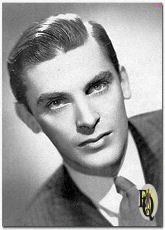 |
| Above right: Photo of a young Richard Hart | |
|
Born
in Providence, Rhode Island as Richard Comstock Hart on April 14. 1915. Hart
was the son and grandson of Henry Clay Hart and Richard Borden Comstock,
leading Rhode Island lawyers. His mother was Marjorie Stewart Comstock. His flair for acting showed up during his childhood when he used to put up on regular backyard theatricals with his brother and sister. But it was a long time before he thought of acting as anything but recreation. After the Moses Brown School he became a 1936 graduate in Psychology and English of Brown University with the firm intention of becoming a journalist, excelled in sports and was All-American center half-back in soccer in his junior year (1935). He never once took part in a college play. In the spring of his senior year at Brown, he sent in his application to Columbia University for post-graduate work in journalism. About that time some of the boys in the fraternity house (he was an Alpha Delta Phi) were planning to go to Europe and spend the summer bicycling through Brittany. Dick's family heard about this project and asked if he wouldn't like to join the other boys. He would an he did. By the time he got home, the fall semester had begun, ant that was the end of his journalism course. However, the bicycling trip more than compensated, for he saw history in the making as few young men have the opportunity. "It rained nearly all the time," Dick once related, "but I had a wonderful time. We went through Brittany and on to Heidelberg and through the Black Forest. We saw Hitler in Munich - it was 1936, and there was quiet a bit if stuff going on then. He was riding down the street in an open car, accompanied by a lot of storm troopers. They had a big Nazi flag in front of the monument for the Unknown Soldier, and all the Germans, as they went past, would salute and say, 'Heil Hitler!' They didn't insist that tourists do the same, but they expected you to. We didn't, and if dirty looks could kill you, I wouldn't be telling about it now. We had a distinct feeling that the sooner we left after that, the better it would be, and we wasted no time about it." Home again, Dick felt that he had to get to work at something, and he chose selling - not because he thought he'd like it, but because he knew he'd hate it! "You see, in New England," he explained, "you get this thing - that if you hate something, you should do it. I couldn't imagine anything worse than selling magazines from door to door, so that's what I decided to do! I remember being in Bedford at the time the World Series was on. I walked into a store one day where a lot of the townspeople were clustered around the radio listening to the ball game, and started my spiel. They all turned around, glaring at me and yelled, 'Shut up!' I was no good at this magazine stuff, so I soon gave it up. Then I sold coal and oil - until I ran out of friends. I couldn't make a sale to any but friends." For three years he worked for the Gorham Silver (Ware) company. During this period, Dick and his whole family - mother, father, brother and sister - began working with the Providence Players, doing everything from scene shifting to playing small parts. This was all in the spirit of fun, and still Dick never considered acting as a way to make a living. Soon after graduation on Saturday, January 15. 1938 he married his teenage sweetheart Eugenia Getchell in the St. Mark's Church of Providence, Rhode Island. |
|
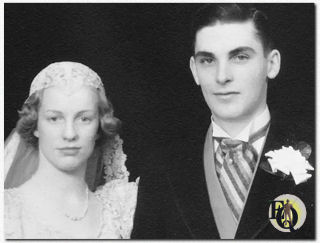 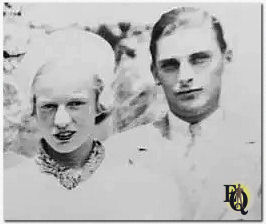 Above left: Wedding portrait of Genie and Richard Hart. (10) Above right: Detail from a family portrait of the 4 Getchell girls and their husbands, seen here Genie and Richie Hart. (10) |
|
|
In 1940 while trying out for the job of a newspaperman for Newport News, he was sent to cover
a story at a nearby stock company. This chance trip through
Tiverton, R.I. introduced him to theater. He visited a friend Bert
Hughes there who was the director of a group known as The Shoestring
Players. The company was desperate for a juvenile lead for a new
offering entitled The Princess and the Hitchhiker, and Dick was
persuaded to take the role.
"I didn't know a thing about acting, but when we ended up with a profit
and had fun doing it, I knew right then and there that acting was the
profession for me," he said. The Shoestring Players
were organized on a co-operative basis, so in addition to acting,
Dick served a general handy man behind the scenes. The show was presented in
the town hall. Admission was sixty cents, and when a handsome profit was
rolled up, Dick got a new slant on the theatrical business and decided to
stick with it. But he was determined to begin at the beginning, and forthwith enrolled with the Tamara Daykarhanova Dramatic School in New York, where he spent two and a half years acquiring a thorough grounding in the fundamentals of acting, speech, dramatic technique, diction, posture. He also did a few soap operas on the radio to help the exchequer. Next came an engagement in summer stock in New England (White Plains,...). His first role was with Tallulah Bankhead and Fred Keating in Her Cardboard Lover (1941). Dick had only two lines to speak, and those were never heard, for he had to deliver them right after Keating's entrance, which always set off a thunderous round of applause. At the Ridgeway Theatre, White Plains, he played in several stock productions. Richard and Eugenie had a son Christopher on August 4. 1940 and we're expected to live in Riverdale (N.Y.C.) by fall. However when he was doing summer stock in New Jersey, his affections with his wife estranged in more ways than just vocational. Eugenia did take her baby boy to live with Hart in Manhattan for a while, but she was back in Providence before his first birthday, seeking a divorce. A year and a half later she married Jonathan Rawson, who adopted Christopher as a son. As part of the American Actors' Company Richard was, reportedly, in Only the Heart a play by Horton Foote (Provincetown Playhouse, Dec 5. - 14. 1942). He also had a semi-professional engagement on stage in It's Up to You, a dramatization of the problems of food rationing and conservation sponsored by the O.P.A. (U.S. Agricultural Department), and presented in local film theatres. A play with a little film in it. It started at Skouras' Academy of Music Theater, New York, Mar 31. 1943. Written by Arthur Arent and directed by Elia Kazan, experience was all that Dick got out of this assignment, since the admission was free. During a season in stock at Cambridge, Mass. Summer Theater, he was second lead in Without Love (Brattle Hall, Jun 14. 1943), which starred Constance Bennett, and was teamed with a pretty little blonde named Louise Valery. They had several ardent love scenes to do in the play, and they soon found that they were looking forward more and more to the enactment of these scenes each day. "By the end of the week," Hart recalled, "we were so hopelessly in love that we were staring endlessly into space!" * They both also played there in Personal Appearance (Brattle Hall, Jul 5. 1943), and The Front Page (Brattle Hall, Jul 12. 1943). During the following Summer season the company's "leading lady" Louise Valery starred in several plays with Richard Hart by her side: Here's To Us (Brattle Hall, Jul 31. 1944), and Winterkill (Brattle Hall, Sep 11. 1944). After a brief Broadway performance in Pillar to Post (Playhouse Theatre, Dec 10. 1943- Jan 1. 1944) came Hart's big break when, as resident juvenile in a summer theater at the Brattle Playhouse in Cambridge, Massachusetts, he played John the witch boy, the lead role in a new play trying out there, Dark of the Moon, a Legend with Music by Howard Richardson and William Berney. It opened without ballyhoo at the Cambridge Summer Theater in Cambridge, Mass. on August 15. 1944. By the next morning reports of its unusual appeal had reached New York and producers began bidding for the right to bring it to Broadway. Louise also starred in Dark of the Moon (Pre- Broadway as the fair witch, and in a smaller role as Ella Bergen). |
|

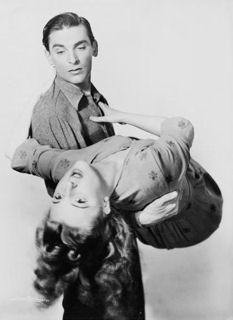 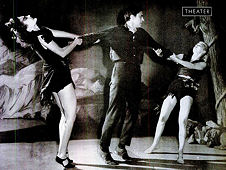
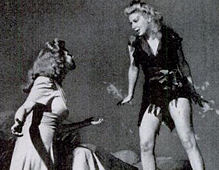 Above left: Publicity shot for Dark of the Moon. On a ridge in Smoky Mountains, John the witch boy (Richard Hart) plays with Comely Witches. After seeing Barbara Allen (left) John wants to be a human. The blonde witch (right) is played here by Louise Valery. Above right: Barbara Allen encounters the blonde witch (Louise Valery). |
|
|
Keeping little of the original company except
Hart the Brothers Shubert took him and the play after seven weeks on the
road to Broadway, where it ran
for nine/ten months in 1945.
Between the performances of Dark of the
Moon (46th Street Theatre, Mar 14. - Dec 15. 1945)
Richard Hart also found time to touring local schools as Romeo in
Romeo and Juliet. He was playing the lead in Dark of the Moon on the New York stage when Metro talent scouts first approached him. He agreed to come to Hollywood but not at that time, because he wanted to stay with the play. The Metro people agreed to wait for a year. That was in March, 1945. Still in love, on November 26. 1945 in Manhattan he married Louise Valery. The ceremony took place at the Collegiate church of St. Nicholas on Fifth Avenue and Forty-Eighth Street. The couple lived in a tiny apartment at Manhattan Beach. Hart won a Theatre World Award for his debut. The Broadway run of 318 performances then led to a national tour. It included Pittsburgh where the play was performed at the Nixon the first week of January 1946. The following spring, when Dick was with the play in Chicago, he received a wire from the studio, asking him to report at once at Metro Goldwyn Mayer "for a lead opposite Greer Garson". Until he arrived in California, he had no idea what part he was being considered for, and had never even made a screen test. He made his debut in Desire Me (aka A Woman of My Own, MGM, Oct 31. 1947) . This production was plagued by problems, including a weak script and conflicts between director George Cukor and actor Robert Mitchum. Cukor was eventually fired and the remaining scenes were directed by three different directors (Mervyn LeRoy, Victor Saville, Jack Conway) and released uncredited. Situated just after WWII, flashbacks tell the story of Marise (Greer Garson), her husband Paul (Mitchum), and Jean Renaud (Hart), who were both imprisoned in a German camp. While attempting to escape from the camp Paul is shot, and Jean goes to see Marise, confirming the news she had gotten already about Paul's death. Jean has fallen in love with Marise and marries her. Paul is still alive.... |
|
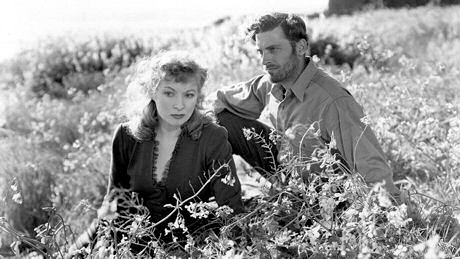
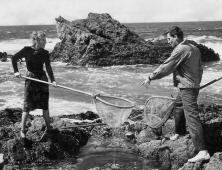
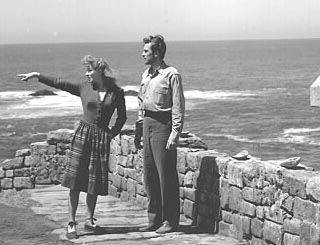 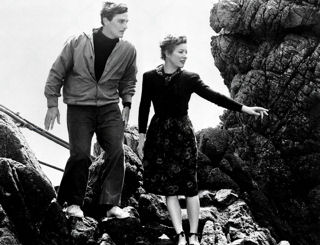
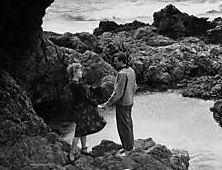 Above: Several scenes from Desire Me (MGM, Oct 31. 1947) with Greer Garson and Richard Hart. |
|
|
During one scene, a huge wave swept Garson and Hart along the jagged rocks
of the Monterey coast. In
mid-April the MGM company of 150 people moved on location to Monterey, at Victorine Ranch below Mal Paso Creek. Greet was delighted to work so near to
her beloved Quail Haven and enjoyed escorting Richard Hart and his wife on
local shopping trips and historical tours. On the morning of the nineteenth, she and Richard were performing the "shrimping" sequence, Cukor had enlisted a local fisherman, Vincent Sollecito, to act as a technical advisor and teach the actors how to use the fishing nets. The scene begins as Greer appears on the porch of Marise's Cliffside home and spots Jean down below. "Where did you learn to catch shrimp?" she called. "I'm just learning now," Hart replied on cue. "Come on down. Come on. You afraid of getting wet?" The line was eerily prophetic, for as Greer descended a stone stairway to the beach an took up her net, ready to fish for the camera, a huge, eight-foot waved swelled up. Before any member of the cast or crew could move, it had crashed down upon them. When the water subsided the camera was still rolling - and the actors had disappeared. Greer was pulled thirty feet along the rocky promontory. A second wave threatened to sweep her into the cove and out to sea. Hart, who had a heart condition and had barely managed to save himself, was in no condition to aid his leading lady. So the cameraman and Vincent Sollecito jumped in after her and, to the relief of everyone, brought her in, covered with cuts and bruises and suffering from exposure. A local physician was notified, and she was taken to the Monterey Community Hospital. L.B. Mayer presented Sollecito with a thousand-dollar check for his rescue, and Greer bought him an engraved eighteen-karat-gold watch. (5) Garson also suffered back problems that would require many surgeries and hospital visits in the following months and years. |
|
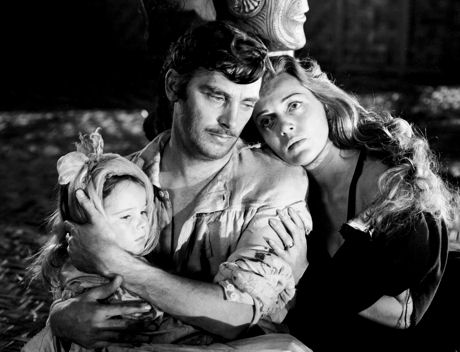
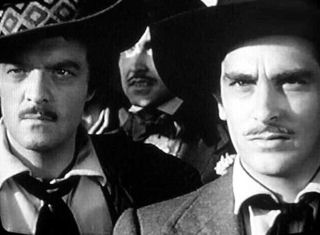 Above left: Child Actress Gigi Perreau, Richard Hart and Lana Turner in Green Dolphin Street (MGM, Oct 15. 1947) Above right: Van Heflin and Richard Hart in Green Dolphin Street (MGM, Oct 15. 1947). |
|
|
Hart showed great promise in his second movie
Green Dolphin Street (MGM, Oct 15. 1947)
which involves two sisters in love with one man.
When she is mistaken for her sister Marguerite (Donna Reed), Marianne
Patourel (Lana Turner) is shipped off to the Antipodes, there to marry
Marguerite's fugitive fiancée, British navy deserter William Ozanne played
by Hart. During the shooting of location shots, he and Lana Turner had a close call when a barge bringing them to shore keeled over and almost threw them into the swirling rapids of the Klamath River in Northern California. Fortunately, quick-thinking grips averted a near tragedy. During filming one evening late December 1946 shortly before their baby was expected - more shortly than they realized - the young Harts attended a sneak preview of his first picture in Pasadena. As the picture unreeled, Mrs. Hart was aware of warning signs. When they came out of the theater, instead of going home, she went straight to the Cedars of Lebanon hospital, where, shortly before midnight a baby daughter made her appearance- all on the night of Friday the 13th! Naturally the event was celebrated next day on the Green Dolphin Street set. Lana Turner, whose thoughtfulness is well known, organized the affair, and the whole company and crew threw a hilarious shower for Dick, literally snowing him under with all sorts of gag gifts as well as the practical items like diapers, books on the care and feeding of infants, etc. |
|
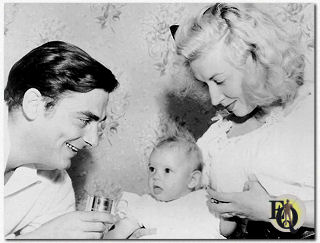 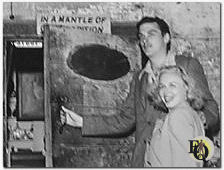 Above left: Richard Hart with Louise Valery and their daughter Hilary. Above right: Mr. and Mrs. Richard Hart, (in 1947) on their first visit to California, see the original state capital, picturesque Monterey. First stop on their tour brings Mr. and Mrs. Hart to the First California Theater built in 1845. The theater is now a State Museum. |
|
|
The Harts found a variety of English country house in
Beverly Hills on a shady avenue, set back from the street in a great clump
of overhanging sycamores. It was not until late spring of 1947 Dick had some time for a vacation. Honeymoon is what they called it, since there had been no time for one at the time of their marriage or since. At first opportunity, they took off, baby and all, for Ensenada, Mexico, where they spent several weeks in the company of her grandma! During the following months of freedom from work Dick parents came out from Providence to visit them for a few weeks. After which Dick and his wife spent another vacation at Palm Springs. Leaving the baby at home with a nurse, fearing the desert heat, they rented a little bungalow, bicycled all over the desert and basked in the sun. However, their marriage was apparently not so ideal, as it was reported that in 1947, he had an illegitimate son named Richard Lee Hart with Phyllis Eileen Buswell. |
|
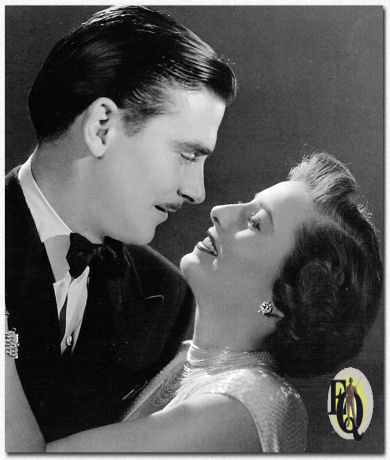 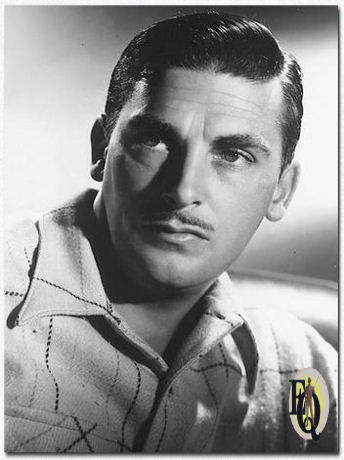 Above left: Richard Hart and Barbara Stanwyck in B.F.'s Daughter (MGM, Mar 24. 1948). Above right: A promotional picture for B.F.'s Daughter (MGM, Mar 24. 1948). |
|
|
Next he played in B.F.'s Daughter
(MGM, Mar 24. 1948).
Barbara Stanwyck plays Polly Fulton, rebellious daughter of a wealthy
industrialist (Charles Coburn). Polly marries a conservative economist
professor Robert S. 'Bob' Tasmin III (Richard
Hart), but she chafes at his values and leaves him for socialist professor
Van Heflin. In England, where the letters "B. F." comprise a euphemism for
"bloody fool", the film was retitled to Polly Fulton. As of 1948 Hart was in an intimate relationship with actress Felice Montealegre, with whom he had performed in several plays. |
|
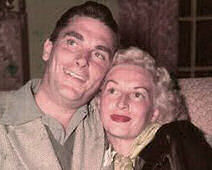 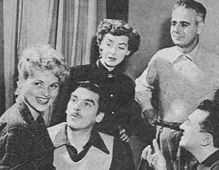 Above left: Richard Hart and Louise Valery. Above right: For the Ford Theatre episode "She Loves Me Not" (CBS, Nov 4. 1949) director Marc Daniels (R) instructs (L to R) Judy Holliday, Richard Hart, Marsha Hunt, Paul Stewart. |
|
|
In 1949 he co-starred in Reign of Terror
(aka The Black Book,
Eagle-Lion, Jul 16. 1949)
as François Barras. It also featured Robert
Cummings, Arlene Dahl, Richard Basehart and Arnold Moss. This movie was
basically "The French Revolution" done as a film-noir. But Richie preferred the stage, where he was at his best. He then voluntarily left MGM to go back to the stage. Back on Broadway he appeared in a flop, Leaf and Bough (Cort Theatre, Jan 21. - 22. 1949) then took over for Sam Wanamaker in Goodbye, My Fancy (Morosco Theatre, Nov 17. 1948 - Dec 24. 1949) and had a hit as the original Uncle Desmonde in The Happy Time (Plymouth Theatre, Jan 24. 1950 - Jul 14. 1951) opposite Claude Dauphin and the young Eva Gabor. |
|

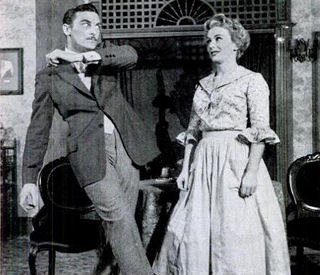 Above left: Richard Hart and Eva Gabor in The Happy Time: A love tap is administered by Uncle Desmonde as he pins one of his numerous medals on pretty Mignonette, a vaudeville acrobat turned maid, whose charms begin to affect him... Above right: Desmonde mimics Rudolph Valentino saying how he approaches more closely with the eyes. He wiggles the nose. "No great trick to wiggle the nose, it demands only a seriousness of purpose. Now he flutters the nostrils...now the teeth! And the smile like he has just smelled a bad piece of fish. Now he bends the woman backwards, it demands only some small cooperation...and now he kisses her". Mignonette upbraids him for being a man who collects garters of all women but finally agrees to marry him. |
|
|
Between 1949 and 1950 he made several appearances on television's The Ford Theatre Hour (CBS, Mar 13. - Nov 4. 1949, min.2), Studio One (CBS, Apr 3. 1949 - Oct 2. 1950, min. 5), The Philco Television Playhouse (NBC, Jul 3. 1949, min. 1), NBC Presents (NBC, Aug 8. 1949, min. 1), The Silver Theater (CBS, Dec 5. 1949, min. 1) and Masterpiece Playhouse (NBC, Jul 23. 1950, min. 1) (playing such roles as Eilert Lovborg in Hedda Gabler and Marc Antony in "Julius Caesar"). For The Philco Television Playhouse Carol Stone and Richard Hart reprised their roles from the Dark of the Moon play. |
|
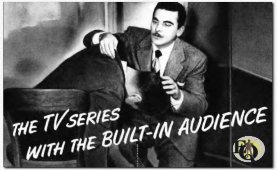 Richard
Hart, big and strapping and sporting an incongruous Errol Flynn moustache,
was the star of
The Adventures of Ellery
Queen
also known as "A Kaiser-Frazer Adventure in Mystery"
(Right). It was the first TV-series to try and bring
to live Ellery Queen and it was aired live and was well done for a
Dumont net program.
Florenz Ames
played his father, Inspector Richard Queen. The show appeared on the Dumont
Network beginning in 1950 and each episode took 25 minutes. Richard
Hart, big and strapping and sporting an incongruous Errol Flynn moustache,
was the star of
The Adventures of Ellery
Queen
also known as "A Kaiser-Frazer Adventure in Mystery"
(Right). It was the first TV-series to try and bring
to live Ellery Queen and it was aired live and was well done for a
Dumont net program.
Florenz Ames
played his father, Inspector Richard Queen. The show appeared on the Dumont
Network beginning in 1950 and each episode took 25 minutes.Hart made a likable enough lead but was heftier than any previous Ellery. He was also adept at ignoring the mistakes which afflicted almost every live broadcast of the time. During one episode’s introduction, Ellery is supposed to stop typing his latest novel upon “noticing” the audience. Hart looked up from the machine just as he pushed the typewriter roll-carriage back—knocking a vase off the desk, out of shot, never to be seen or acknowledged again. Hart did only eleven episodes, three of which were based on previously published Ellery Queen stories, and a fourth, “The Blind Bullet,” which boasted a plot later recycled in the 1952 novel The King Is Dead), and was rehearsing the twelfth when he died of a heart attack. Ironically, that episode was titled “The Survivors’ Club.” So after only four months, less than a third of the way through the season, January 2. 1951, Hart had a heart attack during a rehearsal and died in French Hospital, shortly after he had been rushed there. He was only 35 years old. With less than twenty-four hours notice, his friend Lee Bowman was brought in as replacement in the Ellery Queen series. Lee recalled "Hart died on a Tuesday and I did the show on Thursday. I had no idea of getting into a live series, but they offered it to me, and I stayed." Felicia Montealegre also played alongside Hart in several EQ episodes, something she had done in Studio One. Having broken up with Leonard Bernstein in December 1947, actress Felicia Montealegre had fallen in love with Richard Hart. When she heard about Hart's heart attack she went to him. Leonard went along and sat with her during the crisis. Hart died later that night. She mourned like a widow the death of Richard Hart. Felicia reconciled with Leonard and that led to their marriage in September later that year. |
|
|
Notes: * This anecdote is sometimes attributed to the play Dark of the Moon, but since they met before it's more likely this was an earlier play. All dates for movies are for the first US release. All dates for TV programs are original first airdates. All dates for (radio) plays are for the time span the actor was involved. Facts in red still need confirmation. |
|
|
Click on Uncle Sam if you think you can help out...!
|
|
|
Other references
Additional video & audio sources
|
|
|
This actor profile is a part of
Ellery Queen a website on deduction.
The actor above played Ellery Queen in
an Ellery Queen TV series.
Click Uncle Sam if you think you can help
out...! Many of the profiles on this site have been compiled after very careful research of various sources. Please quote and cite ethically! |
|
|
Page first published before May 22. 2016 Version x 2.3 - Last updated April 22. 2025 |
|
 b a c k
t o L i s t o f S u s p
e c t s
b a c k
t o L i s t o f S u s p
e c t s
|
|
| Introduction | Floor Plan | Q.B.I. |
List of Suspects | Whodunit? | Q.E.D. | Kill as directed | New | Copyright Copyright © MCMXCIX-MMXXV Ellery Queen, a website on deduction. All rights reserved. |